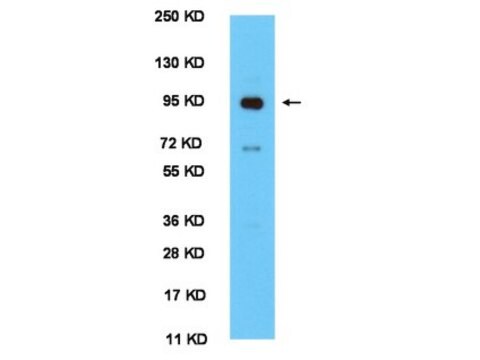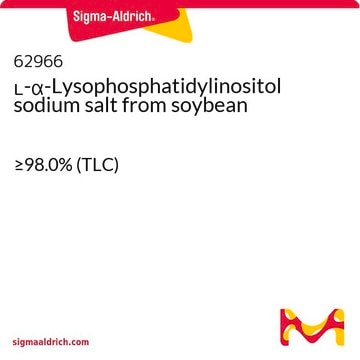Water is typically not an ideal solvent for lipids. The choice of solvent depends on the intended application. A mixture of chloroform, methanol, and acetic acid at a ratio of 95:5:5, could be considered. Ideally, consulting the scientific literature would be necessary to determine if a specific solvent is used for the intended application.
L7260
Oleoyl-L-α-lysophosphatidic acid sodium salt
≥98%, solid
Synonyme(s) :
1-Oleoyl-sn-glycerol 3-phosphate sodium salt, 3-sn-Lysophosphatidic acid, 1-oleoyl sodium salt, LPA sodium salt
Sélectionner une taille de conditionnement
Sélectionner une taille de conditionnement
About This Item
Produits recommandés
Niveau de qualité
Essai
≥98%
Forme
solid
Couleur
white
Type de lipide
phosphoglycerides
Température de stockage
−20°C
Chaîne SMILES
O[C@](COP([O-])(O)=O)([H])COC(CCCCCCC/C=C\CCCCCCCC)=O.[Na+]
InChI
1S/C21H41O7P.Na.H/c1-2-3-4-5-6-7-8-9-10-11-12-13-14-15-16-17-21(23)27-18-20(22)19-28-29(24,25)26;;/h9-10,20,22H,2-8,11-19H2,1H3,(H2,24,25,26);;/b10-9+;;
Clé InChI
CHJOEWDRTPWOCY-TTWKNDKESA-N
Vous recherchez des produits similaires ? Visite Guide de comparaison des produits
Description générale
Application
- for the activation of Ras homolog gene family, member A (RhoA) and expression of claudin-1 in human breast cancer epithelial cell line[4]
- in RH7777 cells for cyclic adenosine monophosphate (cAMP) accumulation assay and calcium mobilisation assay[5]
- in vitro luciferase assay and live-cell imaging[6]
Actions biochimiques/physiologiques
Caractéristiques et avantages
Attention
Notes préparatoires
Code de la classe de stockage
11 - Combustible Solids
Classe de danger pour l'eau (WGK)
WGK 3
Point d'éclair (°F)
Not applicable
Point d'éclair (°C)
Not applicable
Équipement de protection individuelle
Eyeshields, Gloves, type N95 (US)
Faites votre choix parmi les versions les plus récentes :
Certificats d'analyse (COA)
Vous ne trouvez pas la bonne version ?
Si vous avez besoin d'une version particulière, vous pouvez rechercher un certificat spécifique par le numéro de lot.
Déjà en possession de ce produit ?
Retrouvez la documentation relative aux produits que vous avez récemment achetés dans la Bibliothèque de documents.
Les clients ont également consulté
Articles
Discover Bioactive Small Molecules for Lipid Signaling Research
-
What substance can be used to dissolve this product?
1 answer-
Helpful?
-
-
Is this version of the compound cell culture grade?
1 answer-
This product is not cell culture grade. Unfortunately, there is not a LPA sodium salt offered that is cell culture suitable. The suitability for this product in cell culture would have to be determined by the end-user. See below the links to the product datasheet, a sample Certificate of Analysis, and Peer Reviewed Papers, respectively:
Datasheet
https://www.sigmaaldrich.com/deepweb/assets/sigmaaldrich/product/documents/296/848/l7260pis.pdfPeer Reivewed Papers
https://www.sigmaaldrich.com/search/l7260?focus=papers&page=1&perpage=30&sort=relevance&term=l7260&type=citation_searchHelpful?
-
Active Filters
Notre équipe de scientifiques dispose d'une expérience dans tous les secteurs de la recherche, notamment en sciences de la vie, science des matériaux, synthèse chimique, chromatographie, analyse et dans de nombreux autres domaines..
Contacter notre Service technique











